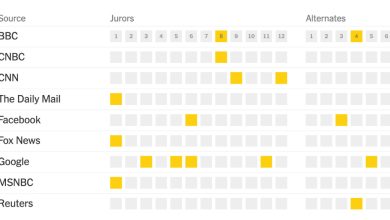Judge Tosses Out New York’s New Political Districts

Good morning. It’s Friday. We’ll look at the latest twist in redistricting in New York. We’ll also catch up on the state budget in Albany, about to be officially late.

Credit…Pool, Vaughn Golden/WSKG
The decision surprised even some Republicans: A judge declared New York’s new legislative maps unconstitutional, saying the map-drawing process led by Democrats had been irrevocably tainted.
The ruling by Justice Patrick McAllister of Steuben County Supreme Court, above, blocked the maps from being used in this year’s elections, potentially throwing midterm congressional contests into turmoil. Candidates have already begun campaigning in the new districts for the primaries, scheduled for June 28. McAllister also invalidated the maps for the Assembly and the State Senate.
The judge, a Republican, said the new congressional maps had broken New York’s new prohibition on partisan gerrymandering — essentially accusing Democrats of the same tactics they have complained about when Republicans used them in red states. “The court finds by clear evidence and beyond a reasonable doubt that the congressional map was unconstitutionally drawn with political bias,” McAllister wrote in his 18-page opinion. The New York congressional maps favor Democrats in 22 of 26 new districts.
McAllister gave the Democrat-led Legislature until April 11 to prepare new “bipartisanly supported maps” for Congress, the State Senate and Assembly. He said that he would appoint an independent special master to draw the lines if lawmakers failed to do so, raising the possibility that June’s party primaries could be delayed.
Gov. Kathy Hochul and Letitia James, the state attorney general, issued a statement together saying they intended to appeal. My colleague Nicholas Fandos writes that such a move would be likely to stay McAllister’s decision and could allow this year’s elections to go ahead using the districts adopted in February.
“This is one step in the process,” said Michael Murphy, a spokesman for the State Senate Democrats. “We always knew this case would be decided by the appellate courts.”
Democrats could challenge the ruling in either the Appellate Division of the Supreme Court or the State Court of Appeals — New York’s highest court. Both tribunals are expected to be more favorable to Democrats than Steuben County, which borders Pennsylvania. It is home to Corning Inc., the glass manufacturer.
“The plaintiffs got what they wanted by going to court in Steuben County,” said Jeffrey Wice, an adjunct professor at New York Law School’s Census and Redistricting Institute. “Whether they carry their victory all the way to the State Court of Appeals is an uphill battle for them.”
What to Know About Redistricting
- Redistricting, Explained: Here are some answers to your most pressing questions about the process that is reshaping American politics.
- Understand Gerrymandering: Can you gerrymander your party to power? Try to draw your own districts in this imaginary state.
- Analysis: For years, the congressional map favored Republicans over Democrats. But in 2022, the map is poised to be surprisingly fair.
- Killing Competition: The number of competitive districts is dropping, as both parties use redistricting to draw themselves into safe seats.
Republicans hailed the ruling and expressed confidence they would win on appeal. John Faso, a former congressman who is serving as a spokesman for the Republican plaintiffs, called it a “complete victory” for the petitioners, who were voters from across the state. But the lawsuit was financed and overseen by Republicans in Washington and Albany who filed it soon after Hochul had signed the new maps into law.
Weather
Prepare for a chance of showers in the early afternoon, with steady temps in the mid-50s. The evening is partly cloudy with temps in the high 30s.
alternate-side parking
In effect until April 14 (Holy Thursday).
Missing a deadline in Albany
As a reporter, I don’t like to think about blowing a deadline. But the State Legislature just blew a big one. The state budget was supposed to be signed, sealed and delivered by midnight — or at least agreed to and maybe voted on.
But my colleagues Luis Ferré-Sadurni and Jesse McKinley write that the State Senate adjourned on Thursday until Monday. The Assembly — which tends to be the slower-moving chamber — also gaveled out.
Gov. Kathy Hochul issued a statement offering a hopeful prognosis, even though her first budget is late. “We are getting closer to agreement, with consensus on major policy items,” she said. “New Yorkers should know that progress is being made.”
While the April 1 deadline is in the State Constitution, the state comptroller’s office said no state checks would be delayed unless a deal is delayed past 4 p.m. on Monday.
Hochul, a Democrat, had proposed a $216.3 billion budget with an eye to jump-starting the state’s recovery from the pandemic. The Legislature, controlled by fellow Democrats, wanted to spend at least $6 billion more. They proposed pumping more money into the State University of New York and the City University of New York — we’re unlikely to know how much until other issues have been settled.
One of those issues is re-reforming the state’s bail law, which the Legislature revised in 2019. Hochul, responding to a pandemic-era rise in crime and perhaps to Republican success in attacking Democrats, called for making more categories of crimes eligible for bail. She also suggested allowing judges to consider how dangerous a defendant was in making bail decisions for those accused of serious felonies. Mayor Eric Adams supports those changes, but they have run into resistance from progressives in the Senate and the Assembly.
Andrea Stewart-Cousins, who leads the State Senate, flatly rejected the dangerousness provision on Thursday. “We’ve always stood the same way,” she said. “We’re not introducing dangerousness.”
Everybody into the pool
It’s a sign that summer is coming: The Department of Parks and Recreation is making a final push to recruit lifeguards for the city’s eight beaches and 53 outdoor pools.
Iris Rodriguez-Rosa, the first deputy parks commissioner, said that finding enough qualified swimmers had been more difficult than before the pandemic. “It’s a national issue, trying to get lifeguards,” she said. “Because of Covid, there were fewer high schools that had swim teams competing. Swimmers missed out on training time because of closed pools. They’re not in as good shape.”
How U.S. Redistricting Works
What is redistricting? It’s the redrawing of the boundaries of congressional and state legislative districts. It happens every 10 years, after the census, to reflect changes in population.
Why is it important this year? With an extremely slim Democratic margin in the House of Representatives, simply redrawing maps in a few key states could determine control of Congress in 2022.
How does it work? The census dictates how many seats in Congress each state will get. Mapmakers then work to ensure that a state’s districts all have roughly the same number of residents, to ensure equal representation in the House.
Who draws the new maps? Each state has its own process. Eleven states leave the mapmaking to an outside panel. But most — 39 states — have state lawmakers draw the new maps for Congress.
If state legislators can draw their own districts, won’t they be biased? Yes. Partisan mapmakers often move district lines — subtly or egregiously — to cluster voters in a way that advances a political goal. This is called gerrymandering.
What is gerrymandering? It refers to the intentional distortion of district maps to give one party an advantage. While all districts must have roughly the same population, mapmakers can make subjective decisions to create a partisan tilt.
Is gerrymandering legal? Yes and no. In 2019, the Supreme Court ruled that the federal courts have no role to play in blocking partisan gerrymanders. However, the court left intact parts of the Voting Rights Act that prohibit racial or ethnic gerrymandering.
Want to know more about redistricting and gerrymandering? Times reporters answer your most pressing questions here.
Lifeguards must sign up for a test, and there are requirements: They must be at least 16 and must pass a vision check (no wearing glasses or contact lenses). Most of all, there is a swim test — lifeguards must be able to cover 50 yards in the water in 35 seconds or less, displaying what the parks department calls “proper form.” Those who pass will undergo 40 hours of training on the way to earning a minimum of $16 an hour.
Rodriguez-Rosa said she had looked in on test sessions in January. “I wish I could do 50 yards,” she said wistfully.
The latest Metro news
-
The future of 421a, a 51-year-old tax-incentive program set to expire in June, is precarious, with fierce lobbying underway to expand the program or kill it entirely.
-
New York City cleared 239 homeless encampments in 12 days, the mayor said. But only five people at those sites agreed to go to shelters.
-
Gregory Schmidt, a real estate reporter for The New York Times, recently learned more about the history of an effort to integrate two communities in New Jersey: South Orange and its neighbor, Maplewood.
-
A Connecticut judge rejected Alex Jones’s claim that he was too ill to sit for a deposition, ruling that the Infowars conspiracy theorist would be subject to escalating daily fines for future delays.
What we’re reading
-
Matthew Gasda spent years writing plays on his electric typewriter, and almost no one seemed to care. With “Dimes Square,” he has an underground hit.
-
Paul Herman, who put in appearances as wiseguys and schlemiels in movies like “Goodfellas” and “Casino” and three seasons of “The Sopranos,” died on Tuesday, his 76th birthday.
METROPOLITAN diary
On a Brooklyn roof
Dear Diary:
i was on a roof in Brooklyn looking down
and had a camera packed, pulled it out
and loaded my last black & white roll of film.
patiently holding still.
saw an empty bird’s nest on a window sill.
guess they all learned to fly, wish ’em well.
saw a well-dressed woman put mail in her purse
and a tricycle with a missing wheel in the dirt.
for what it’s worth:
a photograph’s the only path to time travel in reverse.
across the street,
what looked like a castle at first
was really just the back of the church.
if I got to the rooftop earlier,
would’ve had more time before the moon turning up.
so it wasn’t that long till i put the lens cap back on
and I walked downstairs — fast forward:
back on the block onto the train platform
and the doors were open,
what more could I ask for?
— Leo Coltrane
Illustrated by Agnes Lee. Send submissions here and read more Metropolitan Diary here.
Glad we could get together here. See you tomorrow. — J.B.
P.S. Here’s today’s Mini Crossword and Spelling Bee. You can find all our puzzles here.
Melissa Guerrero, Jeff Boda and Ed Shanahan contributed to New York Today. You can reach the team at [email protected].
.




